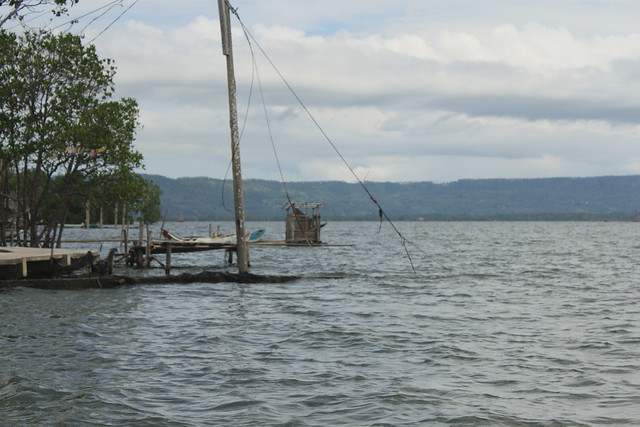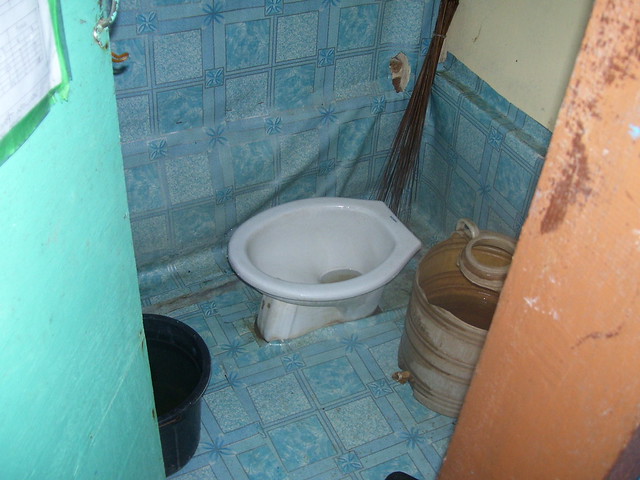- Forum
- categories
- Health and hygiene, schools and other non-household settings
- Schools (sanitation and hygiene in schools)
- Toilets for a flood-prone elementry school in Philippines
Toilets for a flood-prone elementry school in Philippines
24.4k views
- christian.rieck
-
 Topic Author
Topic Author- Moderator
Less- Posts: 118
- Karma: 7
- Likes received: 41
Re: Toilets for a flood-prone elementry school in Philippines
Hi Julian,
Thanks for your assessment. I have been trying to search for the scientific statement on survival of human pathogens in seawater or brackish water. It does not seem all too clear that saltwater is a hostile environment. For example this paper states the following:
drs.nio.org/drs/bitstream/2264/3378/1/En..._Assess_155_245a.pdf (page 2):
Further, different species of bacteria including pathogenic ones (Colwell et al. 1981; Xu et al. 1982; Huq et al. 1984; McCarthy and Khambaty 1994; McCarthy et al. 1996; Wait and Sobsey 2000; Darakas 2001; Ramaiah et al. 2002a) survive in seawater for one to several weeks. Once introduced into the marine environment, allochthonous pathogens of human health concerns can disperse far and wide to other regions.
If you have sources and publications on saltwater being an hostile environment please let me (us) know.
Otherwise I like your idea of the fast flush that is linked to the tide. Do you have any kind of drawing or example on such a device?
@Canaday: Thanks for the ideas on the flood proof UDDTs. I am sure Elmer is interested in this design and he can try to see if the local communities have interest in such a solution. I am however sceptical that people will embrace this technology and thus the additional burden of work in such an environment, where there is no farming and only fishing. Transporting the compost to clients to the main land will be quite expensive. Only if there is already an established market of humanure I would think people would be interested to venture into something like that. But this is only my thought and I might be completely underestimating the situation.
Cheers
Christian
Thanks for your assessment. I have been trying to search for the scientific statement on survival of human pathogens in seawater or brackish water. It does not seem all too clear that saltwater is a hostile environment. For example this paper states the following:
drs.nio.org/drs/bitstream/2264/3378/1/En..._Assess_155_245a.pdf (page 2):
Further, different species of bacteria including pathogenic ones (Colwell et al. 1981; Xu et al. 1982; Huq et al. 1984; McCarthy and Khambaty 1994; McCarthy et al. 1996; Wait and Sobsey 2000; Darakas 2001; Ramaiah et al. 2002a) survive in seawater for one to several weeks. Once introduced into the marine environment, allochthonous pathogens of human health concerns can disperse far and wide to other regions.
If you have sources and publications on saltwater being an hostile environment please let me (us) know.
Otherwise I like your idea of the fast flush that is linked to the tide. Do you have any kind of drawing or example on such a device?
@Canaday: Thanks for the ideas on the flood proof UDDTs. I am sure Elmer is interested in this design and he can try to see if the local communities have interest in such a solution. I am however sceptical that people will embrace this technology and thus the additional burden of work in such an environment, where there is no farming and only fishing. Transporting the compost to clients to the main land will be quite expensive. Only if there is already an established market of humanure I would think people would be interested to venture into something like that. But this is only my thought and I might be completely underestimating the situation.
Cheers
Christian
GIZ Uganda
Enhanced Water Security and Sanitation (ENWASS)
Sanitation for Millions
This email address is being protected from spambots. You need JavaScript enabled to view it.
Enhanced Water Security and Sanitation (ENWASS)
Sanitation for Millions
This email address is being protected from spambots. You need JavaScript enabled to view it.
Please Log in to join the conversation.
You need to login to replychristian.rieck wrote: There seems to be very few incidences of diarrhea as mentioned by the district nurses that accompanied us. Very astonishing indeed!
Saltwater is a quite hostile environment for many faecal bacteria, thus I guess that is not all that astonishing.
Given the fact that I assume the islands are not extremely densely populated, I would say that disposing the faecal waste into the ocean is probably not the worst idea. See it as a way of fertilizing the "fields" in the ocean
What one could experiment with would be a system that utilized the regular flooding to drain the waste further out into the ocean so that it doesn't get washed up on the land during the next tide.
Maybe a tank with a pipline to the ocean that gets filled with water during high tide, and empties out all the water with the faecal waste included during low tide with a fast flush?
One would just have to think of a clever valve setup (or water head differential?) to automate such a system. The outgoing tide would then take out the waste even further. Maybe one could set up an artificial reef there too, in order to use the area as a breeding ground for young fish (as opposed to fishing there directly).
Please Log in to join the conversation.
You need to login to reply
Hi Christian and Elmer,
It is not so complicated to build a UDDT above the flood line, as we did in a fishing village in the mangroves of Ecuador (inodoroseco.blogspot.com/2009/05/inodoro...-zonas-de-altas.html).
In the case shown, plastic barrels were used to collect feces and cover material, but one could simply build a bit higher to allow for using rice sacks or whatever container.
Another solution would be to potentially have floating artificial wetlands for treating wastewater (preferably greywater, while excrement is dealt with in UDDTs). The root zone of aquatic plants is quite effective at cleansing wastewater.
Best wishes,
Chris Canaday
It is not so complicated to build a UDDT above the flood line, as we did in a fishing village in the mangroves of Ecuador (inodoroseco.blogspot.com/2009/05/inodoro...-zonas-de-altas.html).
In the case shown, plastic barrels were used to collect feces and cover material, but one could simply build a bit higher to allow for using rice sacks or whatever container.
Another solution would be to potentially have floating artificial wetlands for treating wastewater (preferably greywater, while excrement is dealt with in UDDTs). The root zone of aquatic plants is quite effective at cleansing wastewater.
Best wishes,
Chris Canaday
Conservation Biologist and EcoSan Promoter
Omaere Ethnobotanical Park
Puyo, Pastaza, Ecuador, South America
inodoroseco.blogspot.com
Omaere Ethnobotanical Park
Puyo, Pastaza, Ecuador, South America
inodoroseco.blogspot.com
The following user(s) like this post: Elmersayre
Please Log in to join the conversation.
You need to login to reply
The Philippines is archipelagic in nature and is composed of more than 7,000 islands so a solution to this technical issue is relevant to so many coastal villages here..
Elmer Sayre
Water, Agroforestry, Nutrition and Development Fdn.
Libertad, Misamis Oriental
9021 Philippines
This email address is being protected from spambots. You need JavaScript enabled to view it.
Water, Agroforestry, Nutrition and Development Fdn.
Libertad, Misamis Oriental
9021 Philippines
This email address is being protected from spambots. You need JavaScript enabled to view it.
Please Log in to join the conversation.
You need to login to reply- christian.rieck
-
 Topic Author
Topic Author- Moderator
Less- Posts: 118
- Karma: 7
- Likes received: 41
Toilets for a flood-prone elementry school in Philippines
Dear all,
I have been visiting a school in the coastal areas of Mindanao, the big southern island of the Philippines (see here for photos www.flickr.com/photos/gtzecosan/sets/72157630223245354/). It is a fishing community that lives right at the edge of the mangroves. They live on fishing farming of grabs, shrimps, fish and clams. The houses are built on stilts as they have regular flooding due to the tides. The local elementry school, called Darumawang , lies on higher ground but gets also flooded completly during high tide in June and July. The school has only 1 pour flush toilet inside one classroom and another 2 toilets newly built outside. It is not clear how the system works. The school teachers were telling us that the toilet is flushing into a plastic tank placed beneath the toilet. We could not see the tanks as everything was flooded. The newly constructed toilet is placed on a concrete conservancy tank, that will get full eventually. There is so far no option to empty the tank. We have seen one similar toilet in the villages. It seems that most children do urinate around the school area and do their big business at home which is close by. Most villagers seem to use toilets that dump the waste directly into the water (see picture below) - the toilets are located slightly outside the village.

A typical toilet offshore for defecation by Sustainable sanitation , on Flickr
The village with around 500 inhabitants has only one water point which is a deep well with slightly salty water. They use this water only for washing or flushing purposes. Drinking water is delivered to the area by boat from a different island.
Now the plan is to improve the sanitation situation for the Darumawang school with a low-cost option that can be replicated easily also by other villages and schools. This is part of a joint activities by Fit for School, Unicef and GIZ that look at simple, scalable and sustainable options.
The biggest issue is on how to dispose the human waste. It seems pretty clear that we cannot implement any dry sanitation system, as this requires a strict following of operational rules and the management of faecal waste. People are just not used to take much care and have lived for ages with the tide flushing out their waste into the ocean. There seems to be very few incidences of diarrhea as mentioned by the district nurses that accompanied us. Very astonishing indeed!

The school ground is slowly flooding by the tide by Sustainable sanitation , on Flickr

School ground during high tide by Sustainable sanitation , on Flickr

One of the few school toilets attached to the classroom by Sustainable sanitation , on Flickr
The only option we see is to build a standard septic tank with a soak pit that will hopefully drain the effluent into the underground during low tide, when the school ground gets dry. Any options on that or ideas on what technological option could fit to this school setting?
Cheers
Christian
I have been visiting a school in the coastal areas of Mindanao, the big southern island of the Philippines (see here for photos www.flickr.com/photos/gtzecosan/sets/72157630223245354/). It is a fishing community that lives right at the edge of the mangroves. They live on fishing farming of grabs, shrimps, fish and clams. The houses are built on stilts as they have regular flooding due to the tides. The local elementry school, called Darumawang , lies on higher ground but gets also flooded completly during high tide in June and July. The school has only 1 pour flush toilet inside one classroom and another 2 toilets newly built outside. It is not clear how the system works. The school teachers were telling us that the toilet is flushing into a plastic tank placed beneath the toilet. We could not see the tanks as everything was flooded. The newly constructed toilet is placed on a concrete conservancy tank, that will get full eventually. There is so far no option to empty the tank. We have seen one similar toilet in the villages. It seems that most children do urinate around the school area and do their big business at home which is close by. Most villagers seem to use toilets that dump the waste directly into the water (see picture below) - the toilets are located slightly outside the village.

A typical toilet offshore for defecation by Sustainable sanitation , on Flickr
The village with around 500 inhabitants has only one water point which is a deep well with slightly salty water. They use this water only for washing or flushing purposes. Drinking water is delivered to the area by boat from a different island.
Now the plan is to improve the sanitation situation for the Darumawang school with a low-cost option that can be replicated easily also by other villages and schools. This is part of a joint activities by Fit for School, Unicef and GIZ that look at simple, scalable and sustainable options.
The biggest issue is on how to dispose the human waste. It seems pretty clear that we cannot implement any dry sanitation system, as this requires a strict following of operational rules and the management of faecal waste. People are just not used to take much care and have lived for ages with the tide flushing out their waste into the ocean. There seems to be very few incidences of diarrhea as mentioned by the district nurses that accompanied us. Very astonishing indeed!

The school ground is slowly flooding by the tide by Sustainable sanitation , on Flickr

School ground during high tide by Sustainable sanitation , on Flickr

One of the few school toilets attached to the classroom by Sustainable sanitation , on Flickr
The only option we see is to build a standard septic tank with a soak pit that will hopefully drain the effluent into the underground during low tide, when the school ground gets dry. Any options on that or ideas on what technological option could fit to this school setting?
Cheers
Christian
GIZ Uganda
Enhanced Water Security and Sanitation (ENWASS)
Sanitation for Millions
This email address is being protected from spambots. You need JavaScript enabled to view it.
Enhanced Water Security and Sanitation (ENWASS)
Sanitation for Millions
This email address is being protected from spambots. You need JavaScript enabled to view it.
Please Log in to join the conversation.
You need to login to reply
Share this thread:
- Forum
- categories
- Health and hygiene, schools and other non-household settings
- Schools (sanitation and hygiene in schools)
- Toilets for a flood-prone elementry school in Philippines
Recently active users. Who else has been active?
Time to create page: 0.126 seconds








